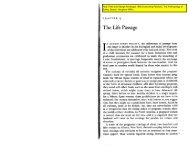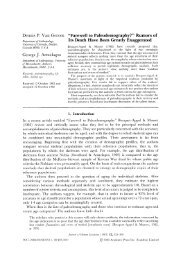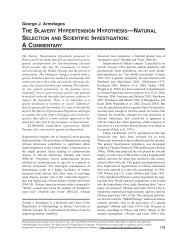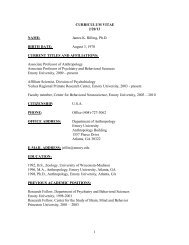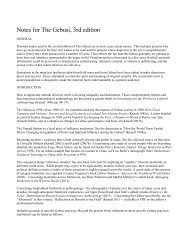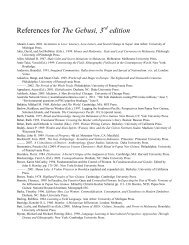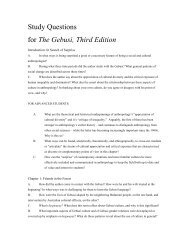Obstetric dimensions of the true pelvis in a Medieval ... - Anthropology
Obstetric dimensions of the true pelvis in a Medieval ... - Anthropology
Obstetric dimensions of the true pelvis in a Medieval ... - Anthropology
Create successful ePaper yourself
Turn your PDF publications into a flip-book with our unique Google optimized e-Paper software.
422<br />
stetric <strong>pelvis</strong>. First, such analysis requires<br />
articulation <strong>of</strong> <strong>the</strong> hip bones with <strong>the</strong><br />
sacrum. The fragmentary nature <strong>of</strong> most ar-<br />
chaeological rema<strong>in</strong>s <strong>of</strong>ten precludes this<br />
procedure. Second, <strong>in</strong>terest <strong>in</strong> sexual dimor-<br />
phism has focused more on sexual diagnosis<br />
than functional <strong>in</strong>terpretation. Both factors<br />
are unfortunate given <strong>the</strong> importance <strong>of</strong><br />
such variation to our understand<strong>in</strong>g <strong>of</strong><br />
growth and nutrition <strong>in</strong> <strong>the</strong> atta<strong>in</strong>ment <strong>of</strong><br />
adult pelvic form as well as <strong>the</strong> impact <strong>of</strong> <strong>the</strong><br />
adult female form on maternal and neonatal<br />
health.<br />
For example, J. L. Angel (1975, 1978,<br />
1982) argued that flatten<strong>in</strong>g <strong>of</strong> <strong>the</strong> pelvic<br />
<strong>in</strong>let is a response to nutritional stress. Cook<br />
(1984) reported that low status Hopewell fe-<br />
males from <strong>the</strong> lower Ill<strong>in</strong>ois Valley had<br />
flatter pelvic <strong>in</strong>lets than did higher status<br />
females. Cook argued that this may be direct<br />
evidence for nutritional stress.<br />
<strong>Obstetric</strong> practitioners, work<strong>in</strong>g with liv-<br />
<strong>in</strong>g populations, have likewise associated<br />
nutritional deficiency with contracture <strong>of</strong><br />
<strong>the</strong> <strong>pelvis</strong> (Baird, 1945,1969; Thomas, 1947,<br />
1956). The modern cl<strong>in</strong>ical focus, however,<br />
has not been on female pelvic morphology<br />
per se but on parturition and fetopelvic dis-<br />
proportion as <strong>the</strong>se affect maternal-neona-<br />
tal morbidity and mortality (Caldwell and<br />
Moloy, 1933; Friedman, 1978; Pritchard et<br />
al., 1985; Thoms, 1956; Thoms et al., 1939).<br />
In this paper we analyze <strong>the</strong> obstetric di-<br />
mensions <strong>of</strong> female pelves from an ancient<br />
Sudanese Nubian population. Our purpose<br />
is to determ<strong>in</strong>e <strong>the</strong> extent to which size re-<br />
duction and contracture <strong>in</strong> <strong>the</strong> <strong>true</strong> <strong>pelvis</strong><br />
had occurred and presented important re-<br />
productive challenges, 1) from <strong>the</strong> stand-<br />
po<strong>in</strong>t <strong>of</strong> obstetric difficulty, and 2) from <strong>the</strong><br />
standpo<strong>in</strong>t <strong>of</strong> neonatal size.<br />
MATERIALS AND METHODS<br />
Sample selection<br />
L. M. SIBLEY ET AL<br />
Materials for <strong>the</strong> present study were excavated<br />
by one <strong>of</strong> us (D.V.G.) <strong>in</strong> 1979 at <strong>the</strong><br />
<strong>Medieval</strong> site <strong>of</strong> Kulubnarti <strong>in</strong> Sudanese<br />
Nubia. The site is located some 80 miles<br />
south <strong>of</strong> Wadi Halfa <strong>in</strong> <strong>the</strong> Republic <strong>of</strong><br />
Sudan. A total <strong>of</strong> 406 <strong>in</strong>dividuals were dis<strong>in</strong>terred<br />
from two cemeteries spann<strong>in</strong>g <strong>the</strong><br />
Due to <strong>the</strong> desert climate <strong>of</strong> Sudanese Nu-<br />
bia, <strong>the</strong> preservation <strong>of</strong> both s<strong>of</strong>t and skele-<br />
tal tissues is exceptional. One female was<br />
discovered buried on a mat with a fetal skel-<br />
etal <strong>in</strong> <strong>the</strong> breech position. It is reasonable<br />
to assume that her death resulted from pro-<br />
longed obstructed labor.<br />
All adult females (ages 1944) with com-<br />
plete pelvic rema<strong>in</strong>s, lack<strong>in</strong>g gross morpho-<br />
logical abnormalities and without adher<strong>in</strong>g<br />
s<strong>of</strong>t tissues that would impede measure-<br />
ment, were <strong>in</strong>cluded <strong>in</strong> <strong>the</strong> analysis<br />
(n = 36). Age at death was determ<strong>in</strong>ed by<br />
observations <strong>of</strong> epiphyseal union, morphol-<br />
ogy <strong>of</strong> <strong>the</strong> 0s pubis, dental wear, and degen-<br />
erative changes <strong>of</strong> articular surfaces (Van<br />
Gerven et al., 1981). Mean age at death for<br />
<strong>the</strong> sample was 30.5 2 6.9 years.<br />
Of <strong>the</strong> 36 <strong>in</strong>dividuals analyzed, 10 were<br />
sexed positively on <strong>the</strong> basis <strong>of</strong> s<strong>of</strong>t tissues<br />
(breasts and genitalia) and <strong>the</strong> rema<strong>in</strong>der<br />
were sexed accord<strong>in</strong>g to morphology <strong>of</strong> <strong>the</strong><br />
<strong>pelvis</strong>, <strong>in</strong>clud<strong>in</strong>g sciatic notch morphology,<br />
elevation <strong>of</strong> <strong>the</strong> auricular surface, subpubic<br />
angle, pubiclischial <strong>in</strong>dex, and presence <strong>of</strong> a<br />
pre-auricular sulcus. It should be noted that<br />
such estimation <strong>of</strong> sex is unlikely to con-<br />
found <strong>the</strong> present analysis through an <strong>in</strong>ad-<br />
vertent <strong>in</strong>clusion <strong>of</strong> mis-sexed male pelves.<br />
Earlier analysis <strong>of</strong> both males and females<br />
<strong>of</strong> known sex produced non-overlapp<strong>in</strong>g<br />
male-female morphological distributions,<br />
and <strong>the</strong> <strong>in</strong>dividuals utilized <strong>in</strong> <strong>the</strong> present<br />
sample fall so well with<strong>in</strong> <strong>the</strong> female pattern<br />
that <strong>the</strong> likelihood <strong>of</strong> misdiagnosis is re-<br />
mote.<br />
Procedures and <strong>in</strong>struments<br />
Anthropometric measurements were<br />
taken <strong>of</strong> each <strong>true</strong> obstetric <strong>pelvis</strong>, def<strong>in</strong>ed<br />
as that portion <strong>of</strong> <strong>the</strong> <strong>pelvis</strong> ly<strong>in</strong>g below and<br />
<strong>in</strong>clud<strong>in</strong>g <strong>the</strong> pelvic brim. This anatomical<br />
area has obstetric significance s<strong>in</strong>ce it is <strong>the</strong><br />
bony canal through which <strong>the</strong> fetus must<br />
pass dur<strong>in</strong>g parturition. To facilitate de-<br />
scription and analysis, <strong>the</strong> <strong>true</strong> <strong>pelvis</strong> was<br />
divided <strong>in</strong>to three functional planes: <strong>the</strong> <strong>in</strong>-<br />
let, mid<strong>pelvis</strong>, and <strong>the</strong> outlet.<br />
The plane <strong>of</strong> <strong>the</strong> <strong>in</strong>let is bounded anteri-<br />
orly by <strong>the</strong> posterior superior marg<strong>in</strong> <strong>of</strong> <strong>the</strong><br />
pubic symphysis, laterally by <strong>the</strong> l<strong>in</strong>ea ter-<br />
m<strong>in</strong>alis, and posteriorly by <strong>the</strong> promontory<br />
current era from 550 to c. 1550.- and alae <strong>of</strong> <strong>the</strong> sacrum (Oxorn and Foote,



